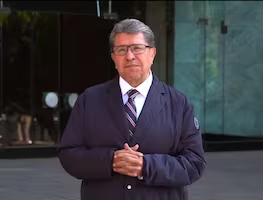Más Información

Inicia pago de la Pensión del Bienestar del bimestre enero-febrero; estas son las fechas de depósito

Violencia en el país evidencía colapso de estrategia de seguridad: PRI; insiste en cambiar el rumbo de combate

Defensa toma protesta al general Maximiliano Cruz Ramos; fungirá como Inspector y Contralor General de División de Estado Mayor

Sheinbaum destaca reducción de homicidios dolosos en último mes de 2024; “Confiamos en nuestra estrategia”, dice

Sheinbaum no hablará de seguridad en reunión con presidentes municipales; revisarán tema de infraestructura
72 million years ago, the territory surrounding Coahuila was very different. Instead of deserts, there were swamps. The fresh water from rivers and lagoons reached the sea at different points and the humidity of the environment allowed exuberant vegetation to grow. There, probably a hadrosaur was stalked by a giant crocodile , and the recently discovered Yehuecauhceratops mudei must have been somewhere in there as well. This ceratopsid dinosaur, a family popularly known for having horns on their face, became the cherry on top of ten years of research by a group of scientists led by specialists from the Desert Museum ( Mude ) in Saltillo , Coahuila , northern Mexico.
The adventure began in 2007 when the National Institute of Anthropology and History ( INAH ) gave the green light to the project " Dinosaurs of the Coahuila Desert Region ," an initiative of the Mude to locate dinosaur fossils in different places in the state. Hector Rivera Sylva , Head of Paleology at the Mude, points out that in Mexico there have been important dinosaur discoveries, yet very sporadic. "They are very rare, there is not a broad fauna of this sort such as the ones located in Canada and the U.S. We only have a handful of dinosaurs for Mexico," he assures.
The first remains found in our territory were those of a Troodon " Wounding Tooth " in 1856 . This small omnivore had a morphological similarity to the great raptors and it was one of the first dinosaurs to be known in the continent. It was found in Coahuila and Baja California Norte , northern Mexico.
More than a century after this discovery, only a dozen others have been recorded, such as Tototlmimus packardensis , a long-necked dinosaur with a beak and without teeth, located in the Cabullona Basin in Sonora , northwest Mexico. In addition to some discoveries, mainly in the north of the country, the Huehuecanahutlus tiquichensis , a herbivorous dinosaur with sharp jaws stands out in Michoacán .
For José Rubén Gúzman Gutiérrez , vertebrate paleontologist and Mude collaborator, the low record of dinosaur discoveries in Mexico has to do with a series of factors. For instance, during the Mesozoic era , the period in which dinosaurs lived, Mexico was under the sea. "The terrestrial part of the continent was a very small strip, basically in the North, in what is now Baja California , Sonora , Chihuahua , and Coahuila ," adding that another reason is that there are very few paleontologists in Mexico. “We have that disadvantage because there are very few institutions that are dedicated to paleontology in general and there are even less in dinosaurs. This is why our records are smaller compared to the U.S., Canada, and even Argentina ."
For Rivera Sylva, this sort of discovery places Mexico in the global arena on the study of dinosaurs opening possibilities beyond Ocampo , such as Sabinas , General Cepeda , Parras de la Fuente and Ramos Arizpe , other municipalities in Coahuila .
The Yehuecauhceratops mudei was discovered in Ocampo. It had herbivorous habits and as it could reach three meters high as an adult. "The sediments where it was found indicate that it inhabited ciénegas (a wetland system unique to the American Southwest) and areas bordering the coast. It must have lived among tyrannosaurs and giant crocodiles, as well as hadrosaurs."
Hints to decipher the future
Another contribution of paleontology is the historical information on climate change, a phenomenon that although accelerated by the influence of man, has also been observed in the world in a natural way throughout of time, turning, for example, coasts into deserts.
“I believe paleontology is a window to science and it may be another way for children to become interested in scientific vocations, as astronomy also does," concluded Gúzman Gutiérrez.
sg





